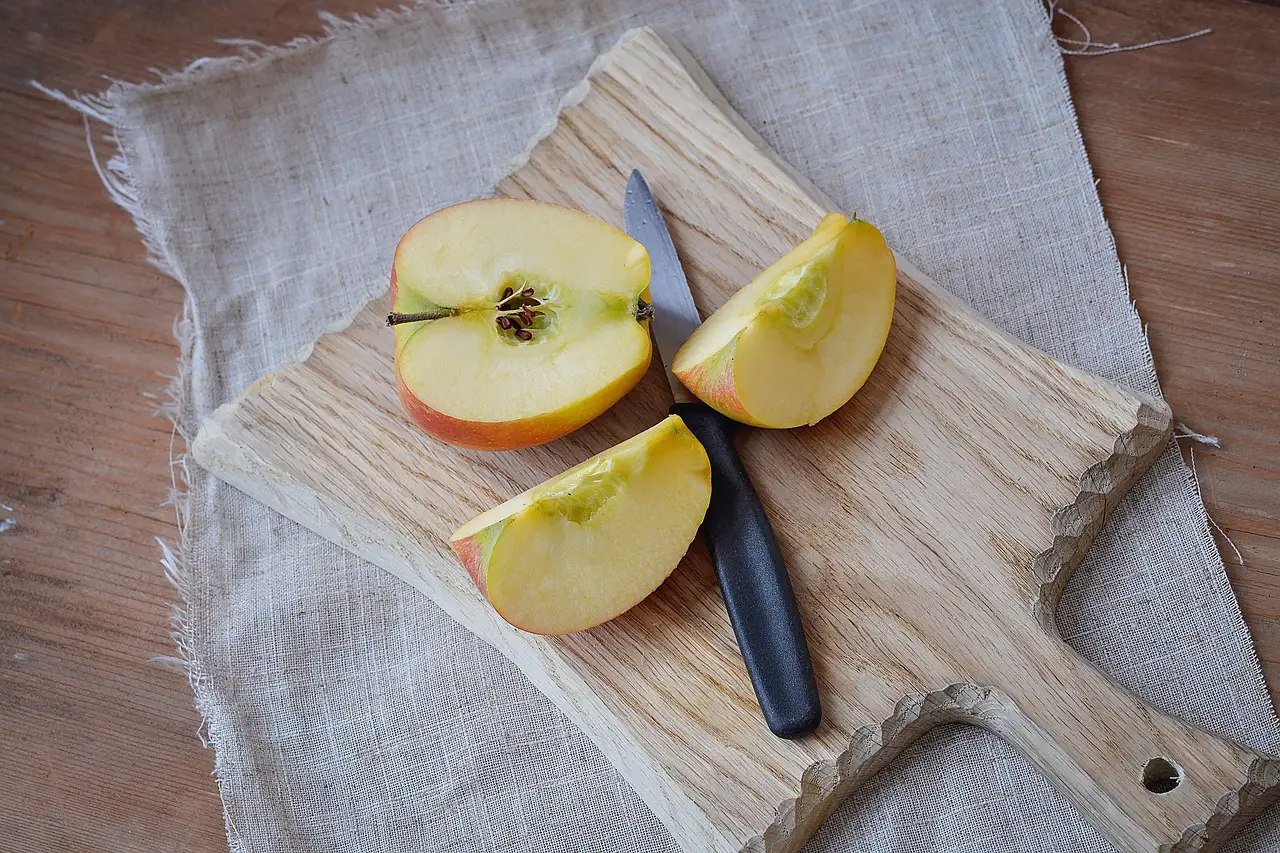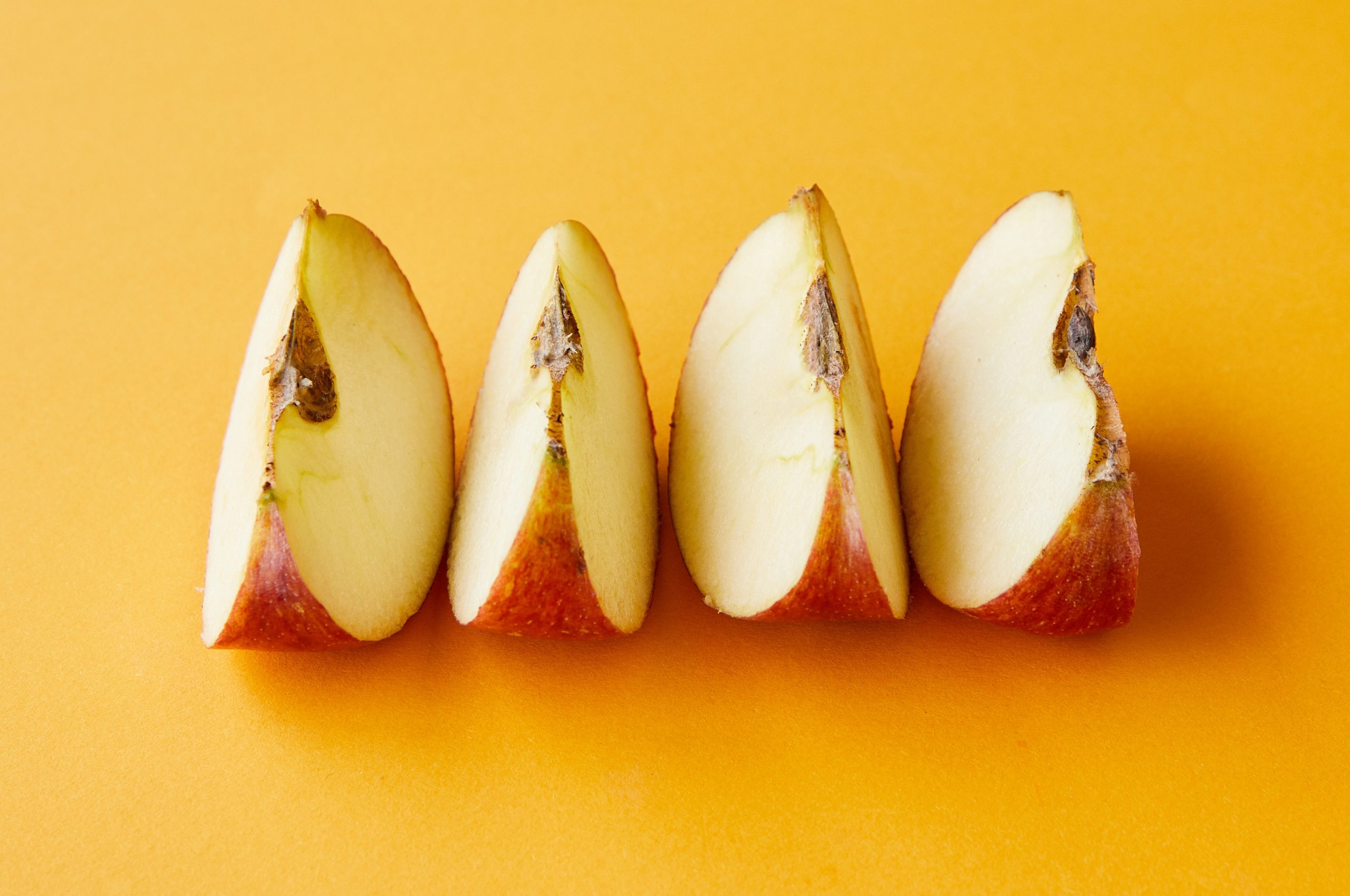If you have lots of apples during the fall months, you may want to freeze them. Frozen fruit has a longer shelf life and can be stored in an airtight container for up to six months. It may not taste as well and may even lose its texture after a few months, but it’s still a great way to store your produce.
Whole or sliced apple slices are easy to freeze. A few hours before putting them in the freezer, you’ll need to soak the fruit in water. This helps to prevent it from browning. Then, you’ll need to transfer the fruit to a parchment paper-lined sheet pan. Place the pan in the freezer for at least two hours.

How to Freeze Apple Slices?
Follow these steps to freeze apple slices:
- Peel, core, and wash the apples.
- Apples should be sliced to the required thickness.
- Put the pieces on a baking sheet with a silicone mat or parchment paper.
- The apple slices should be crisp and frozen in the freezer after one to two hours. Place the baking sheet in the freezer.
- Once the slices are frozen, move them to an airtight container or resealable plastic bag, sucking out as much air as possible.
- Put the date and the kind of fruit on the bag or container’s label.
- For up to 8 months, keep the frozen apple slices in the freezer.
To stop the slices from browning before freezing, mix them with lemon juice or ascorbic acid.
How to Defrost Frozen Apple Slices?
There are a few techniques you can employ to defrost frozen apple slices:
- Method using room temperature: Put the frozen apple slices in a bowl or on a plate and let them sit there until they are completely thawed, about an hour.
- Method for the refrigerator: Put the frozen apple slices in a bowl or platter, then wrap them in aluminum foil or plastic. Depending on the quantity, place them in the refrigerator and let them thaw overnight or for several hours.
- Method for using a microwave: Put the frozen apple slices in a bowl that can be used in a microwave, add a little water, and cover the bowl with plastic wrap or a lid. When the apple slices are thawed, microwave them on defrost or low power for a few minutes, inspecting and stirring them occasionally.
After thawing, the apple slices can be added to dishes or enjoyed as a snack. Remember that the apple slices’ texture may have altered, and they will likely be more soft and juicy after defrosting.
How to Store Apple Slices?
Slices of apples should be stored in a way that keeps them from browning and preserves their freshness for as long as possible.
Here are some pointers for keeping apple slices fresh:
- Mix the pieces with ascorbic acid or lemon juice: As a result, the apple slices won’t rot from being exposed to air.
- Keep them in a sealable plastic bag or an airtight container: Reducing the apple slices’ exposure to air will help keep them fresh.
- Please place them in the fridge: Store the apple slices in the refrigerator to halt the decay process and preserve their freshness for longer.
Store them in the freezer: Apple slices can be frozen to be kept for a longer amount of time. Ensure they are enclosed in a resealable plastic bag or an airtight container.
It’s vital to remember that after being frozen and thawed, apple slices will have a different feel; they will be softer and juicier.
How to Make Apple Slices at Home?
What you’ll need to create apple slices at home is:
- Apples (any variety) (any variety)
- A mandoline or a sharp knife
- A chopping block
- Ascorbic acid or lemon juice (optional)
To produce apple slices, follow these steps:
- The apples should be properly washed before dried with a fresh cloth or paper towel.
- Use a sharp knife to remove the apple’s top and bottom.
- Apple should be divided in half, top to bottom.
- Cut around the core and seeds in each apple half to remove them with a knife.
- Using a mandoline or a sharp knife, slice the apple halves into slices of the desired thickness.
- Toss the apple slices with either lemon juice or ascorbic acid to stop them from browning.
- You can either use the apple slices right away or store them as mentioned above.
Note: Peeling the apples before slicing is optional and not required.
How do you Keep Apple Slices from Turning Brown?
There are a few strategies to prevent apple slices from fading, such as:
- Pour lemon juice over the apple slices before storing them. Lemon juice’s acidity helps shield food from browning.
- Ascorbic acid: Prepare an ascorbic acid and water solution, then dip the apple slices before storing them.
- Citric acid: Prepare a citric acid solution and water, similar to ascorbic acid, and dip apple slices in it.
- Limit their exposure to air by storing the apple slices in an airtight container or resealable plastic bag. This will prevent the apple slices from browning too quickly.
- Refrigerate them: Storing the apple slices in the fridge will halt the decay process and keep them fresh for a longer period.
- Store them in the freezer: Apple slices can be frozen to be kept for a longer amount of time. Ensure they are enclosed in a resealable plastic bag or an airtight container.
- It’s vital to remember that after being frozen and thawed, apple slices will have a different feel; they will be softer and juicier.
How do you Make Apple Slices Last Longer?
Here are some tips for extending the shelf life of apple slices.
- Place them in the fridge: The apple slices will stay fresher for longer if you store them in the refrigerator, which will also slow the decay process.
- Put them in an airtight container: You may reduce the apple slices’ exposure to air, which will hasten the decomposition process, by storing them in an airtight container or resealable plastic bag.
- Lemon juice or ascorbic acid can be added to the apple slices before serving to stop them from browning due to exposure to air.
- Maintaining them in the freezer: You can freeze the apple slices if you want to keep them longer. Make sure the seals are tight.
- Utilize them quickly: To reduce the time the apples are exposed to air, use them as soon as you can after cutting them.
- Keep them away from other fruits and vegetables when storing: Fruits and vegetables release ethylene gas, which can hasten the ripening and spoilage of other food.
- It’s vital to remember that after being frozen and thawed, apple slices will have a different feel; they will be softer and juicier.
How Long will Apples Last After Slicing?
The type of apple and the manner of storage are only a few variables that will affect how long it will last. After being sliced, apples will last less because the air is exposed to the flesh, causing it to oxidize and turn brown. Here are some ballpark figures:
Fresh apple slices: Apples can be stored in the refrigerator for about 2-3 days after being sliced if they are kept in an airtight container or for up to a week if you soak them in ascorbic acid solution or lemon juice.
Sliced apples already packaged from the store: Apple slices that have been pre-sliced and put in store-bought packaging will keep in the fridge for about 3 to 5 days.
Slices of frozen apples: Slices of firm apples can be preserved in the freezer for several months if kept in an airtight container or resealable plastic bag.
To prevent food-borne infections, it’s crucial to pay attention to the apple slices’ expiration date, smell, and appearance and toss any apple slices that exhibit signs of spoiling.
To get the greatest flavor and texture out of the apples, eating them as soon as you can after cutting them is ideal.
How to Identify Apple Slices are Gone Bad?
Apple slices can become rotten for some reasons, as shown below:
- If there are brown spots or other deterioration on the apple slices, they have probably already started to rot.
- Apple slices that are soft or mushy in texture are probably spoiled and should not be eaten.
- Apple slices should not be eaten if they have an odd or off-smelling odor since they have likely deteriorated.
- Apple slices with mold should be discarded because they are likely rotten.
- Apple slices that have wrinkles or have shriveled indicate that they have lost moisture and are no longer fresh.
- Pay attention to the expiration date and remember that after being frozen and thawed, apple slices will alter in texture, becoming juicier and softer.
- To prevent food-borne infections, it is usually better to throw away any apple slices that exhibit signs of spoiling.
What are the Adverse Effects on Health After Consuming Spoiled Apple Slices?
Consuming rotten apple slices can result in food poisoning, which can manifest in several symptoms, including:
- Nauseous: You can feel ill in your stomach and possibly vomit.
- Consuming damaged apple slices can make you sick and dizzy, making you thirsty.
- After swallowing apple slices that have gone bad, you could have stomach cramps and discomfort.
- Headaches: Food poisoning has been linked in certain cases to headaches.
- Fatigue: Food poisoning can leave you feeling extremely weak and exhausted.
- Fever: In some circumstances, food poisoning can cause an uproar.
- It’s crucial to remember that these symptoms might differ from person to person and can also be brought on by other things. It is essential to seek medical assistance if you suffer severe symptoms or if they last longer than a few days.
- To avoid contracting a foodborne illness, throwing away any apple slices that exhibit signs of deterioration is crucial.
For two hours, elise apple slices were osmo-dehydrated in erythritol, xylitol, and sucrose. In several areas of the experiment, ultrasound pre-treatment (US) lasting 30 minutes was used. Following that, fruit samples were dried using three different techniques: convection (CD), microwave-vacuum (VM), and a combination of the two (CD/VM). The study’s primary goal was to describe how the drying process, sonication pre-treatment, and osmotic dehydration affected the physicochemical characteristics of the dried apples. The use of sugar alcohols (xylitol, erythritol) in the production of dried apples did not significantly alter the taste of the finished products; however, it did enable a pronounced cooling/refreshing effect experienced in the mouth when consuming a snack and allowed the production of dried snacks with lower calorific values.
Conclusion
Freezing is one option if you’re looking to keep apple slices fresher and longer. You can freeze apples whole, cut them into pieces, and freeze them individually. There are a few advantages to freezing apples and a few disadvantages.
The first benefit of freezing is storing your apple slices for months. Apples that are frozen and stored in an airtight container can be frozen for up to a year. That means you can use them for apple pie, smoothies, and other recipes for fresh apples.
